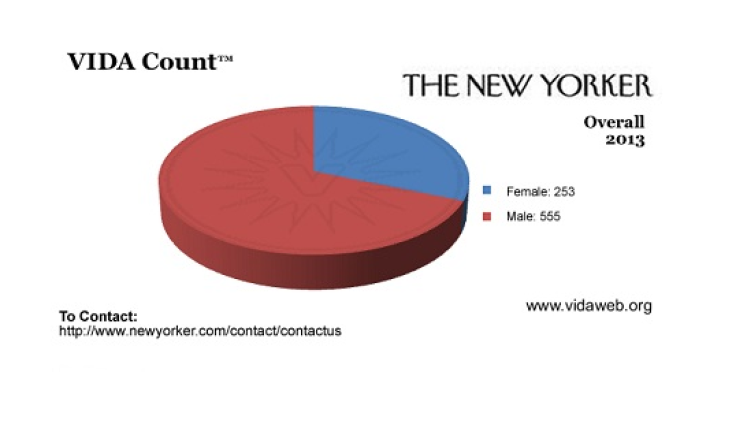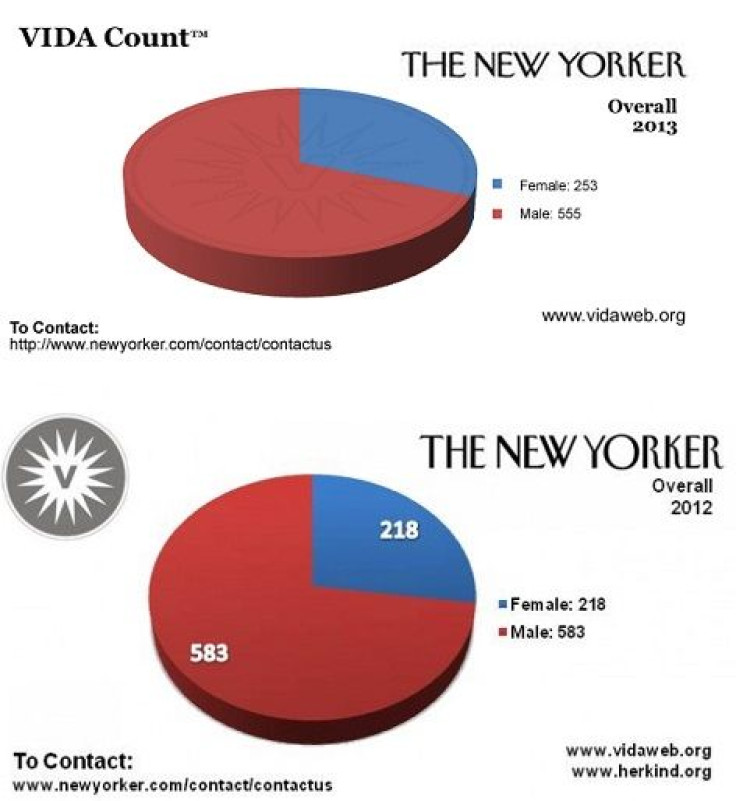Book Reviews Are A Boys' Club: VIDA Count Finds Women Still A Rare Sight On Pages Of Major Literary Magazines

Where are the women of the literary world? You’re less likely to find them between the covers of The New Yorker, The Atlantic or The New Republic, it turns out.
On Monday, the nonprofit group VIDA: Women in Literary Arts released the results of its 2013 Count, which tallies the numbers of men and women who wrote book reviews or had their books reviewed in major literary magazines. This year’s results showed a few publications approaching gender parity, but for a lot of the big guns, it was (man-favoring) business as usual.
VIDA (the name isn’t an acronym for anything, in case you were curious) was founded by two female poets, Cate Marvin and Erin Belieu, in 2009. They were frustrated not just by the lack of women represented in the pages of elite magazines, but by the lack of awareness of just how huge the disparities were.
The idea came in a "moment of loathing and terror and revolutionary spark," Belieu told Mother Jones in 2012.
Some publications have shown a remarkable turnaround since the VIDA Count began. In 2012, The Paris Review’s pages were a total boys’ club, almost 80 percent male overall. In 2013, it swung around to almost complete gender parity: 48 women and 47 men featured or bylined.
“While such progress is remarkable in one year, we are likewise pleased to note that we haven’t heard anyone bemoan a drop in quality in The Paris Review’s pages,” VIDA said in a statement. “Turnarounds like the Paris Review’s make it clear that with the right editorial effort, putting more sustainable gender practices into action isn’t too difficult for these magazines at the top of the major market heap.”
But progress toward gender parity was not universal. Liberal political magazine The New Republic had its most male-dominated year in 2013 since VIDA began crunching the numbers. TNR’s also part of a club of magazines – some of the most influential in the literary world -- where the gender distribution was 75 percent or more male: the Atlantic, the Nation, the New Yorker, the London Review of Books, and the New York Review of Books (80 percent male for four years, by VIDA’s count).
Last year, New York Review of Books editor Robert Silvers responded to the VIDA count with a prepared statement listing the women who appeared in the publication’s print and online editions.
“No one who has read the work of these writers could say that the New York Review dismisses the work of women writers generally, or that the New York Review ‘believes women have little to add to our country's literary conversation,’” Silvers wrote.
The VIDA numbers certainly aren’t a complete picture of women’s writing – consumer and general interest magazines, as well as newspapers at large, aren’t represented. And editors like Silvers will point out that the Count doesn’t represent other female contributions to publications: some essays, letters to the editor, or online writing goes unrecorded. But however sliced, the portrait of the literary world shows a place where, still, a woman's voice is less likely to be heard than a man's.
“One of the things that is brilliant about the Count is there's a gorgeous simplicity to it,” Belieu told Mother Jones. “We did not go into this thinking we knew the answer to something and this was going to illustrate it, because this is a complicated issue. But you can't deny the starkness of such an incredibly wide discrepancy.”
Below, some snapshots from this year’s overall results, and the 2012 numbers for comparison:
The New Yorker:

The Paris Review:

The New Republic:

The Atlantic:

© Copyright IBTimes 2024. All rights reserved.











